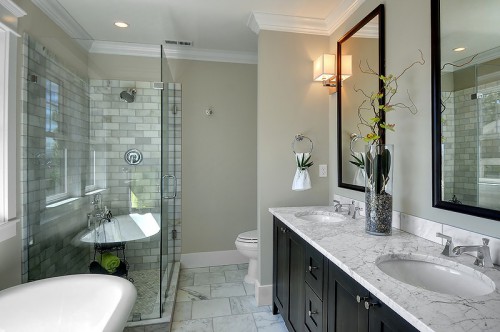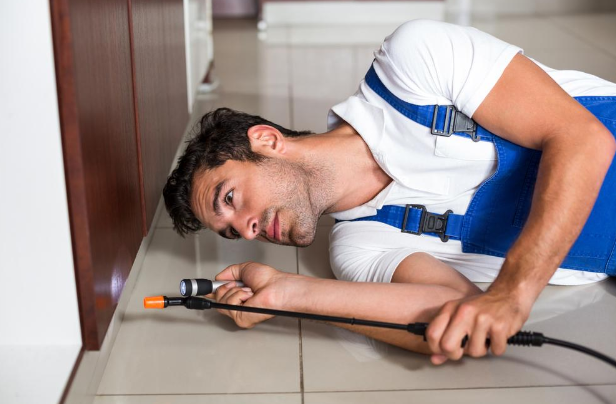

When it comes time to remodel your bathroom, or create it from scratch, one important decision involves the material you’ll use for the floor. With some of the bigger decisions that go into constructing a bathroom, the flooring often gets left behind, but it is a crucial part of a bathroom design and can greatly add or deter from the other aesthetics that make your bathroom beautiful and unique. When it comes to bathroom flooring, the choices are varied. Materials include anything from carpeted floors to wood and tile floors. There are pros and cons to each of these choices, and the cost, material and design are almost certain to be a vital decision maker. Here are the positive and negative aspects of each choice, as well as some things to consider before making a commitment.
Carpet
A more traditional and perhaps, now old-fashioned style, carpeted bathrooms are most often seen in master bathrooms that are connected to a master bedroom. Carpet can be a great way of creating a luxurious and sophisticated bathroom that promotes relaxation and health. However, carpet also has its disadvantages. Ever spill a bottle of shampoo or soap in the bathroom? What about that one time when little Johnny was sick and couldn’t quite make it all the way to the toilet? Carpet will be much more difficult to clean and maintain over time than will other types of flooring. If you have a free standing tub that easily overflows or ever happen to deal with a clogged toilet, this could be very bad news for your carpeted bathroom.
Wood
A beautiful choice that seems to have value no matter what style your bathroom takes, is wood (or laminate, if you’re open to saving a few bucks for the same look). Whether your bathroom follows an antique style, a modern style, a rustic style or something in between, wood is almost always a choice with which you can’t go wrong. Wood gives you several choices with the same look, as well. Laminate is slightly cheaper than engineered wood (real wood backed with plywood), but gives off the same look as a pure wood floor. Engineered wood resists humidity and can be a great choice if you live in a humid area or don’t have any windows in your bathroom with which to ventilate the steam. Conversely, wood is also not a friend to water, and if you know that your bathroom usage might be susceptible to water or other fluid leaks, it might not be the best choice for your bathroom remodel.
Tile
Tile is one of the most popular flooring choices for not only bathrooms, but for the entirety of your home’s flooring. Tile serves as a great flooring option, because it comes in so many different shapes, styles and colors. Ceramic tile is one of the best choices for bathrooms, because it is durable, waterproof and stain-resistant. Ceramic tile is also known for being slip-resistant, which makes it a great choice for any bathroom that has children running in and out at any given time. Tile is an all-around great choice for the bathroom, but it can be tricky to install, and it can be one of the more expensive materials to purchase. The cost of the tile, plus installation can start to add up, especially if you have a bathroom that’s on the larger side.
Cork
A less popular option, cork floors can actually be a great choice and will allow you to create a more sustainable space in your home. Cork can come in a variety of styles and colors and often looks very similar to wood or laminate flooring. The cork material is made from bark and is highly renewable and a great resource for the environment. It is resistant to mold and mildew and it is also water resistant. Cork is also an affordable option for those looking to save room in their budget to splurge on other aspects of the bathroom remodel.
Bamboo
Bamboo is another highly sustainable resource, though not quite as cost effective as cork. On the other hand, bamboo is often undifferentiated from wood, while costing about half the price as true hardwood floors. Bamboo is relatively easy to install, making them a can-do DIY project, and the planks of bamboo are also easy to replace, which is always a great fallback for unseen disasters. For bathrooms, engineered bamboo is the recommended choice, because the planks are durable and withstand humid environments better than some other materials.
These are some of the most popular options for bathroom flooring, and we hope they help you get a head start in your bathroom flooring planning. If you’re remodeling, what type of flooring did you have before, and are you making any changes? If you’re still figuring out the flooring for your new space, what key factors are helping you make a decision? Leave your feedback in the comments below, and let us know which type of flooring you think works best in the bathroom!
Contributed by: Aaron Gruenke author and foremost expert in bathroom fixtures and bathroom design.






